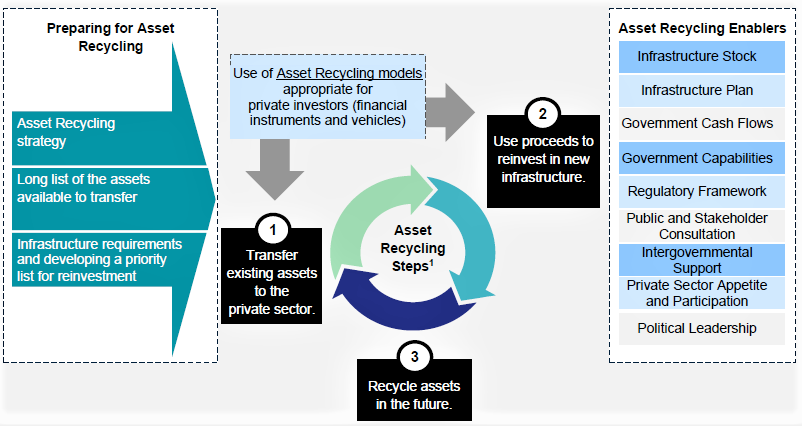Asset Recycling: Decision Maker’s Notes
While there has always been a gap between infrastructure required and what the governments can afford, the infrastructure funding gap has widened significantly over the past few years. Governments are seeking innovative solutions to mitigate this gap and accelerate the delivery of the much-required infrastructure. Asset Recycling has proven to be a very effective and innovative funding model that allows governments to essentially leverage infrastructure assets on their balance sheet to unlock funding for new infrastructure.
To find more, download the full pdf version of Asset Recycling: Decision Maker’s Notes (Coming soon), or visit the Guidelines to Implementing Asset Recycling Transactions section.
Asset Recycling as an Infrastructure Funding Tool
Asset Recycling or AR involves the transfer of existing public infrastructure to the private sector and reinvesting the transfer proceeds into prioritized infrastructure needs — with the intention of creating a robust infrastructure pipeline. This transfer of assets can include brownfield public-private partnerships (PPPs) or concessions, leasing of assets (including land), and/or complete or partial sale of an asset (including shares and other capital market instruments like infrastructure investment funds, Real Estate Investment Trusts (REITs), etc.).
How Asset Recycling Helps Governments
|
Benefits
|
|
Transfer of public assets to unlock capital for new infrastructure projects
|
-
Funding earmarked for infrastructure projects that could 1) enable economic growth, 2) benefit the community and 3) deliver jobs and local capacity building.
-
Repayment of outstanding debt on existing assets without additional burden on local or government budgets.
-
Enable infrastructure development without increasing debt or taxes.
-
Leverage underutilized or unproductive assets through transfer of operating and/or ownership rights.
-
Create new revenue streams through investing in income-generating assets.
|
|
Leveraging private sector expertise and resources through optimal risk allocation
|
|
Asset Recycling comprises three distinct steps:
(1) Transfer: Monetizing infrastructure assets through transfer to the private sector.
(2) Reinvestment: Investing transfer proceeds in prioritized (ideally greenfield) infrastructure assets.
(3) Recycle: Monetizing Step 2 infrastructure assets once operational and de-risked to create funding for new infrastructure investments.
Asset Recycling distinguishes itself from other funding or financing approaches by sequestering and investing all asset transfer proceeds from the private sector into infrastructure assets - Asset Recycling is better defined as an infrastructure development funding tool rather than a government financing tool. Therefore, Asset Recycling can complement traditional infrastructure development programs and the respective budget-allocation processes by purposefully and strategically directing proceeds towards infrastructure development.
Implementing Asset Recycling
Before implementing Asset Recycling, it is important to develop an Asset Recycling strategy that will essentially provide an action plan starting from identifying the objectives to be achieved, assessing the available resources, and deciding on the process to be adopted to achieve the goals. The diagram below summarizes the primary components and considerations when developing an Asset Recycling framework. The framework should cover the objectives that are to be achieved with the Asset Recycling initiative, provide guidance on the process of preparing and executing Asset Recycling, and also consider the assessment of key enablers.
Asset Recycling Framework

Setting up an Asset Recycling initiative is a significant undertaking and requires a considerable level of effort. A robust regulatory and legislative environment, existing infrastructure stock, infrastructure project pipeline, dedicated political leadership, effective stakeholder management and transparency are all key ingredients in steering the success of the Asset Recycling initiatives.
 Key learnings and insights from Asset Recycling initiatives
Key learnings and insights from Asset Recycling initiatives
Around the world, some recurring themes under successful Asset Recycling initiatives include (i) enabling government structure and supportive regulation for privatization or asset transfers, (ii) clear government strategy on Asset Recycling along with public engagement and political support, (iii) attractive public asset inventories, (iv) well-developed infrastructure plan, and (v) presence of independent and competent infrastructure agency/unit to promote transparency.
The review also suggested that Asset Recycling is not a one-size-fits-all model and is not always the suitable solution to fund new infrastructure; in fact, it should be analyzed as one of the options for financing infrastructure assets.
“Asset Recycling: Decision maker’s notes” provides practitioners with a well-considered overview of Asset Recycling programs. It identifies the prospective benefits and highlights the requirements for successfully establishing such a program. It also provides case studies to illustrate the implementation of Asset Recycling in different regions, noting the opportunity to tailor such programs to the particularities of local markets and thus their applicability to markets at differing stages of developing their capital markets, in addition to their stock of bankable infrastructure projects.
1 Atkins Acuity. Recycling our Infrastructure for Future Generations. World Economic Forum, 2017
Related Sections




